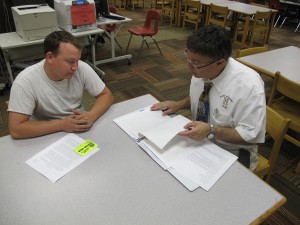What Three Indiana School Corporations Learned About Evaluating Teachers

Kyle Stokes / StateImpact Indiana
Monroe County Community Schools teacher Amy Swafford reads to her third grade class at Clear Creek Elementary.
For as long as most educators can remember, teacher evaluations have been fairly informal — an administrator popping in once or twice a year, observing the teacher for a few minutes and moving on to the next classroom.
But that’s about to change, thanks to a state law requiring districts evaluate their teachers annually. Indiana is calling for assessments that are not just more methodical, but more consequential, too: Teacher pay is to be linked to these evaluations.
Fort Wayne is one place where you can see this future in action. There, principals have begun visiting classrooms for a minute or two nearly every day. They use iPads to take notes on what they see, and teachers get an email at the end of the day with comments from their administrator.
—Erin Raper, Bloomfield teacher
According to Laura Cain, who has worked to implement the new system, the more regular schedule of assessment makes it easier for administrators to identify problem areas and opportunities for teacher professional development.
“They really are quick visits,” says Krista Stockman, a spokesperson for the district. “While obviously there is a time commitment, I think both the principals and the teachers have learned how valuable it is.”
Old Evaluations ‘Didn’t Fit Education As We Know It Today’
Under the new Indiana law, schools must use an assessment that includes some kind of objective data — like scores on standardized tests — and link teacher performance to pay. But the state doesn’t spell out what system districts must use.
The Indiana Department of Education has developed a tool that any district can use, called “RISE.” At the heart of the system is a rubric, or scorecard, that rates teachers on 19 different criteria meant to evaluate how well they plan lessons, teach classes and lead their peers.
Nearly 80 percent of school corporations plan to use that rubric, says says Assistant State Superintendent Dale Chu.Last year, three school districts gave RISE a test ride. Fort Wayne was one of them. The others were Bloomfield and Greensburg. A report on the results of the three pilots will be released later this summer, and the state education department will incorporate that feedback into an updated resource handbook before school starts in August.
In interviews with StateImpact Indiana, administrators from the three pilot districts acknowledged that the new system is a big change and requires a lot of preparation. But they all said better feedback will help teachers improve their practice.
Existing evaluation systems “didn’t fit education as we know it today,” says Bloomfield Superintendent Dan Sichting. Classroom culture has changed. Technology has advanced. Educators approach classroom differently than they did 20 years ago.
‘It Comes Down To Whether You Get The Merit Pay’
One way education has changed is with the recent focus on test scores. The new law says part of every teacher’s effectiveness rating must come from test score data. But this is a touchy subject with teachers. So at least for the pilot program in Bloomfield, test scores were left out of teacher ratings — although teachers could see how they would have fared if test scores had been a factor.
Sichting says he wanted his teachers to focus on their classroom instruction, not test scores. “There were no stakes this year,” he says.
Not every Bloomfield teacher was happy with his or her score, says Erin Raper, president of the district’s teacher association.
—Erin Raper, Bloomfield teacher
“It’s been a little difficult for some of our teachers, as the final score turned out a little lower than they anticipated,” says Raper, who teaches sixth grade. “They were kind of told ahead of time not to expect fours, but there’s this expectation that as professionals we’re going to get super ratings.”
Raper also says there’s a misconception that teachers don’t want to be evaluated. He says his own evaluations were helpful. During the pilot program, administrators provided “an extra set of eyes” and helped him identify students who were struggling. That sparked conversations about different styles of teaching he found helpful.
But while many teachers are receptive to feedback, Raper says linking pay to performance creates competition where cooperation is needed.
“It comes down to whether you get the merit pay or the teacher across the hall gets the merit pay,” says Raper. “If I’ve scored the merit pay and ask my colleague for help, they’re going to say, ‘You’re the expert, you do it.'”
‘Think Very, Very Concretely About Setting Goals’
Then there’s the issue of “objective data,” which the new law requires. Teachers are nervous enough about basing pay decisions on one day of testing, says Sichting. But what about educators who teach subjects like art and music, where students don’t take statewide tests?

Elle Moxley / StateImpact Indiana
Janet Craig, left, and Maple Elementary outdoor learning center coordinator Jennifer Davies talk to the pre-kindergarten students about the importance of being quiet in the hallway at school.
The state’s evaluation system puts those teachers in their own category and expects them to set what are called “student learning objectives.” Essentially, they come up with their own gauge for measuring how much their students learn in a year.
“The work being done around student learning objectives is completely new,” says Chu. “We’re asking educators to think very, very concretely about setting goals in ways most educators have not done before.”
For example, Sichting says a band teacher might ask students to play a scale. The teacher would then grade the student on their mastery of the subject, and the administrator would grade the teacher on how many students passed her test.
“The first thing we’ve told other schools is that you better start on student learning objectives this year,” Sichting says. “The more time you have to look at things the better off you’re going to be.”
But how Raper explains it might be a little easier to get your head around. Teachers already set goals for how far they want their class to get each week, each semester, each year. Now they need a test or measure to demonstrate to administrators how much students are learning.
‘This Will Really Back Up What Goes On In The Classroom’
Fort Wayne’s Cain says that after a year of observation, most teachers are feeling comfortable with the district’s evaluation tools. But she says schools who are just beginning their own assessment programs need to talk through the expectations with educators and explain what effective teaching looks like.
All three of the districts that piloted RISE say they’ll use the scorecard developed by the state next year, though Cain says Fort Wayne administrators plan to continue their daily classroom visits. (The IDOE model calls for five visits a year but doesn’t require daily observations.)
—Krista Stockman, Fort Wayne spokesperson
In Greensburg, Superintendent Tom Hunter says he’s glad the district was part of the teacher evaluation pilot because it’s given administrators more time to get comfortable with the process of evaluating teachers. Before, evaluations were only done every three years and few opportunities for feedback existed.
“I think this will really back up what goes on in the classroom with data,” Hunter says. “It’s cut and dry. You’re a good teacher because you do a, b, c, d, e, f and g.”
Raper’s advice to teachers who will be evaluated for the first time in the fall? “Use it to grow with.
“I didn’t pretend like this year didn’t count because it did,” he says. “The dollars weren’t tied to it, but it was still an evaluation.”



